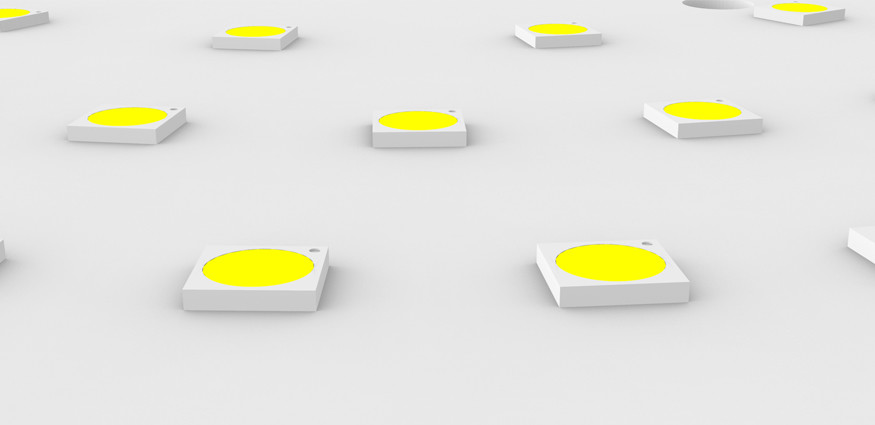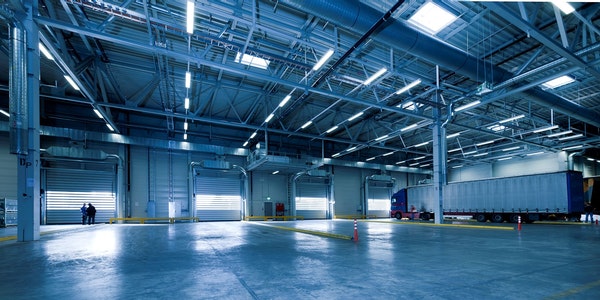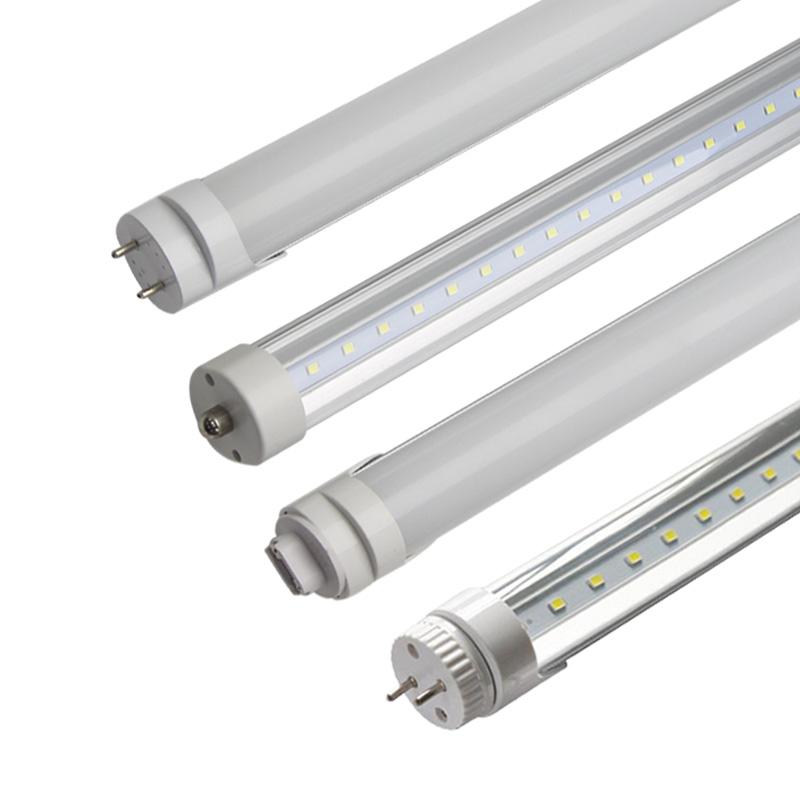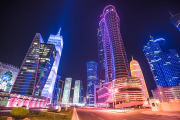What is LED Fluorescent Tube
LED fluorescent tube is commonly known as straight tube lamp, which is a substitute for traditional fluorescent tube, which is embodied in two aspects of energy saving and environmental protection. The size and installation method is the same as that of traditional fluorescent lamps, but the light-emitting principle is to use LED semiconductor chips to emit light. According to the shell material, it is divided into two categories, one is glass, the other is aluminum and PC. The luminous efficiency is 90lm/W~200lm/W
There are two types of LED tubes in the market according to different connection methods: single-ended wiring and double-ended wiring. If the lamp can pass the safety certification, it must be single-ended power supply, and the driving requirement is constant current isolation. According to EU CE requirements, double-ended power supply lamps have safety hazards and do not meet EU standards. So our daily use is mostly single-ended wiring lamps.
Single-ended power supply is a safer design than double-ended. When using a double-ended energized lamp, when you install one end of the lamp into the bracket, and then install the other end, if your hand touches the PIN or aluminum, it will It may form a circuit loop (someone with a little physical knowledge should understand it), so there is a risk of electric shock, so the current integrated lamp tube is also safer with single-ended energization.
Advantages of LED fluorescent tubes
High light efficiency:
Manufactured with internationally famous brand LED light source, the lamp efficiency is up to 115lm/w, which is 70% energy-saving than traditional fluorescent lamps.
High color rendering:
The color rendering index CRI=80, which can truly reproduce the original bright colors of the object and create a comfortable light environment. Long life: The lamp tube is made of glass tube material with good thermal conductivity, and is equipped with a high thermal conductivity special aluminum alloy radiator to ensure that the junction temperature of the LED is always below 80 ℃, 10,000 hours of light decay <8%, and a service life of up to 50,000 hours.
Safe and reliable: The power supply has multiple protection functions such as lightning protection, overvoltage protection, overcurrent protection, circuit breaker protection, short circuit protection, etc., meeting the safety requirements of electromagnetic compatibility, harmonics, withstand voltage, and insulation. Failure rate <1/1000.
Green:
It meets the requirements of the European Rohs Directive, and does not have the disadvantages of mercury and ultraviolet pollution of traditional fluorescent lamps. Constant DC current drives the LED to emit light, the light is pure and soft.
Durable:
The pure heat-conducting glass tube never deteriorates and turns yellow, and the luminous maintenance rate is high.
Strong versatility:
Wide voltage (AC85-265V) power supply design, stable operation even if the voltage fluctuates greatly. Applicable to global mains voltage.
Professional and beautiful:
Created by professional lighting design masters, who understand the market needs. Super cost-effective: It has strong application substitution and cost-effectiveness, and has a competitive advantage in the industry.
Applications
- Large factories, production workshops, workbenches, office interior lighting,
- Indoor lighting in shopping malls and supermarkets,
- The underground parking lot can be used 24 hours a day, which saves a lot of electricity.
- Hospital indoor lighting,
- School classroom lighting,
- Family.
Features
- Environmental protection lamps, protect the earth,
- Efficient conversion, reduce heat generation,
- Quiet and comfortable, no noise,
- Soft light, protect eyes,
- No ultraviolet rays, no mosquitoes,
- The voltage is adjustable from 85V to 265V,
- Save energy and have a longer life span,
- Strong and reliable, long-term use,
- Compared with ordinary fluorescent lamps, LED fluorescent lamps need no ballast, no starter, no strobe,
10 Maintenance-free, frequent switching will not cause any damage,
- Safe and stable quality, can withstand 4kv high voltage, low heat dissipation, can work at low temperature -30℃ and high temperature 55℃,
- Good vibration resistance and easy to transport.
- Energy saving, long life, good applicability, because of the small size of a single LED, it can be made into any shape, short response time, environmental protection, no harmful metals, easy to recycle waste, brilliant colors, pure luminous colors, and spectral range It is narrow and can be mixed into colorful or white light through the three primary colors of red, green and blue.
Luminous efficiency
It is generally called the external quantum efficiency of the component, which is the product of the internal quantum efficiency of the component and the extraction efficiency of the component. The so-called internal quantum efficiency of the component is actually the electro-optical conversion efficiency of the component itself, which is mainly related to the characteristics of the component itself (such as the energy band, defects, and impurities of the component material), and the barrier crystal composition and structure of the component. The extraction efficiency of the component refers to the number of photons generated inside the component that can actually be measured outside the component after the absorption, refraction, and reflection of the component itself. Therefore, factors related to the extraction efficiency include the absorption of the component material itself, the geometric structure of the component, the refractive index difference of the component and the packaging material, and the scattering characteristics of the component structure.
The product of the internal quantum efficiency of the component and the extraction efficiency of the component is the luminous effect of the entire component, that is, the external quantum efficiency of the component. Early component development focused on improving its internal quantum efficiency. The main method was to improve the quality of the barrier crystal and change the structure of the barrier crystal to make it difficult to convert electrical energy into heat, thereby indirectly increasing the luminous efficiency of the LED, so that about 70% of the theory can be obtained. Internal quantum efficiency, but such internal quantum efficiency is almost close to the theoretical limit. Under such conditions, it is impossible to increase the total light quantity of the module by simply improving the internal quantum efficiency of the module. Therefore, improving the extraction efficiency of the module has become an important research topic. The main methods are: changing the shape of the crystal grain-TIP structure, surface roughening technology.
How to Choose LED Fluorescent Lamp
LED fluorescent lamps are very professional, and most people can’t tell them clearly. The following 5 tips tell you that you can choose the correct LED tube without an instrument.
- Look at the packaging and labels
National compulsory product LED lighting manufacturers mark the following on the package: rated voltage range, rated power, and rated frequency. In general, the printed high-quality products are of good quality, clear handwriting, not easy to fall off, wipe with a soft damp cloth, the logo is clear and identifiable, the manufacturer’s trademark and related certification marks.
- Look at the appearance of the LED tube
Real LED fluorescent lamp. From the perspective of the lamp, the shape and size of the lamp are better and more consistent, the product consistency is good, and the quality assurance is easier. Of course, there can be no cracks or looseness between the interfaces. The led tube must choose the kind of engineering plastic flame-retardant plastic PC shell. Ordinary plastic deformation and flammability, the aluminum tube must be bright, aviation aluminum.
- Working temperature
When the LED fluorescent lamp is in normal operation, the temperature should be low. Otherwise, the life span of the LED lamp is very short. At the same time, when the energy-saving lamp is lit, it flickers rapidly or fluctuates very harshly, indicating that the energy-saving lamp has a quality problem. After a few minutes of power on, there should be a temperature, which proves that the heat dissipation is good, and the aluminum substrate used for heat dissipation. There is no temperature, it is a fiberglass board, and the heat cannot be dissipated.
- Look at the startup performance
The start-up of the LED fluorescent lamp has a characteristic: it lights up when it is powered on, and does not flicker.
- Weigh the weight, compare the weight with each other, the heavier is better than the lighter, and the heavier means the material is used well.
Precautions for high-power LED tubes
Heat dissipation
The single-ended LED tube has one end of the power input, and it is generally used with an integrated tube (the tube and the bracket are integrated). The double-ended LED tube has the same appearance as the traditional ordinary fluorescent tube. There are pins at both ends and the power supply is distributed at one end. Root powered lamp. Before installation, you must see the logo on the lamp tube or outsourcing switch, and install it according to the instructions of the lamp. If the appearance is the same, it is difficult to distinguish, you can use a multimeter to measure whether the pins at both ends are closed circuits.
In the application process of high-power LED products and devices, heat dissipation, electrostatic protection, and welding have a great influence on their characteristics, and they need to be highly valued by application-side customers. Heat dissipation, due to the limitations of semiconductor light-emitting diode chip technology, the photoelectric conversion efficiency of LEDs needs to be improved, especially high-power LEDs, because of their higher power, about 60% of the electrical energy will be released as heat (with the development of semiconductor technology) Development, the photoelectric conversion efficiency will gradually improve), which requires end customers to do a good job of heat dissipation when applying high-power LED products to ensure that high-power LED products work normally.
- Heat sink requirements. Shape and material: If the sealing requirements of the finished product are not high, it can directly convection with the outside air environment. It is recommended to use finned aluminum or copper heat sinks.
- Effective heat dissipation surface area: For 1W high-power LED white light (other colors are basically the same), it is recommended that the total effective heat dissipation surface area of the heat sink is ≥50-60 square centimeters. For 3W products, it is recommended that the total effective heat dissipation surface area of the heat sink is ≥150 square centimeters. Higher power depends on the situation and test results. Try to ensure that the temperature of the heat sink does not exceed 60°C.
- Connection method: When connecting the high-power LED substrate and the heat sink, please ensure that the two contact surfaces are flat and in good contact. In order to strengthen the combination of the two contact surfaces, it is recommended to coat the bottom of the LED substrate or the surface of the heat sink with a layer of thermal grease (thermal silicon Grease thermal conductivity ≥3.0W/mk), thermal conductive silicone grease should be applied evenly and in an appropriate amount, and then fixed with screws.
Static Protection
LEDs are semiconductor devices and are more sensitive to static electricity, especially for white, green, blue, and purple LEDs to prevent and eliminate static electricity.
- The generation of static electricity:
① Friction: In daily life, any two objects of different materials are contacted and then separated, and static electricity can be generated. The more common method of generating static electricity is to generate electricity by friction. The better the insulation of the material, the easier it is to generate electricity by friction. In addition, any two objects of different materials can be separated after contacting them, which can also generate static electricity.
② Induction: For conductive materials, since electrons can flow freely on its surface, if it is placed in an electric field, because the same sex repels and the opposite sex attracts each other, positive and negative ions will be transferred and charges will be generated on the surface .
③ Conduction: For conductive materials, because electrons can flow freely on its surface, such as contact with a charged object, charge transfer will occur.
- The harm of static electricity to LED:
① Due to the heat generated by the instant electric field or current, the LED is locally injured. The leakage current increases rapidly and can still work, but the brightness is reduced and the service life is damaged.
②Due to the electric field or current destroying the insulating layer of the LED, the device cannot work (completely destroyed), and it appears as a dead light.
- Electrostatic protection and elimination measures:
For the entire process (production, testing, packaging, etc.), all employees who are in direct contact with the LED must take measures to prevent and eliminate static electricity, including:
***Lay anti-static floor in the workshop and do a good job of grounding.
***The workbench is an anti-static workbench, and the production machine is well grounded.
***The operator wears anti-static clothes, anti-static wristbands, gloves or foot rings.
***Application of ion fan.
***Do a good job of grounding the soldering iron.
***The packaging is made of anti-static materials.

welding:
Please pay attention to choosing a constant temperature soldering iron when soldering. The soldering temperature is below 260℃, and the contact time between the soldering iron and the LED pad should not exceed 3S.
If it is a high-power LED packaged with silicone, the high heat-resistant temperature of silicone is 180°C, so the soldering temperature of the LED should not exceed 170°C. Use low-temperature soldering iron and low-temperature solder paste (wire) to solder, soldering iron and LED pad once The contact time does not exceed 3S.







